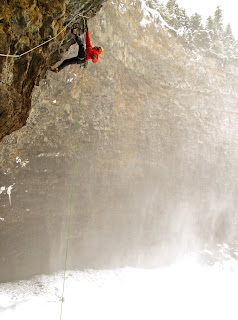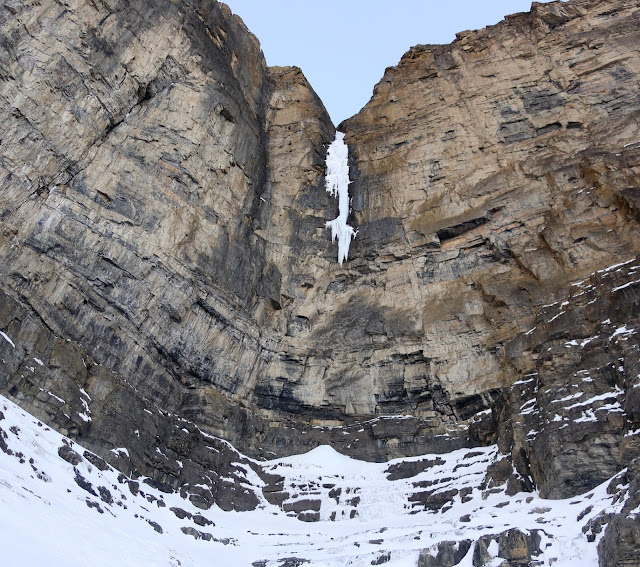Of horseshoes and hand grenades
It's good to end a climbing trip with some business still unfinished. It gives one the excuse to dream, to train, and to go back. Where the spray cave behind Helmcken Falls is concerned, given its potential for serious fun, it's hard to see how one could ever tie up all loose ends. All the same, walking out of the canyon at the end of my first visit there, I could have definitely used another day - or three.
Take the enduro pitch of Wolverine for example: only a few metres left of Spray On, but without the kneebars, stems and solid ice of the latter, it felt noticeably harder. As I watched Klem Premerl and Tim Emmett figure out intricate, powerful sequences through the initial roof, I didn't think I would stand much of a chance on it. But after an afternoon of trying out the tool matches, stein pulls and deadpoints for myself, the wolverine turned into more of a honey badger: still nasty but not completely unreasonable. And so when on our last morning in the cave, before the ass-numbing drive back home, I pulled through the roof on my first redpoint go, I though I had it in the bag. I should have known better. All around me giant ice feathers ominously dripped in the humid warmth, and thin ice turned to mush. Already on easier ground, with just a few moves to go to fat ice, a placement ripped and I was off. So was a big icicle somewhere, except it made a lot more noise as it crashed to the ground, a reminder that the cave is not a good place to be when temps rise above freezing. But I could not leave now that I was so close. On my second try, when another placement ripped ejecting me once again within spitting distance of good ice, my screams of frustration drowned out the sounds of collapsing ice. Now it was really time to get the hell out.
Outrageously fun as spray ice climbing is, I doubt I would have returned just for a one-pitch test piece. But in the meantime Klem and Tim had completed Spray On Top, a multi-pitch adventure all the way to the canyon rim. Before seeing the cave for myself I might have been able to shrug off Tim's enthusiastic emails as so much hyperbole. But now I knew better. His talk of hanging daggers, wild moves and pitch after pitch of overhanging mixed climbing had me scanning the forecast for Wells Gray Provincial Park daily, hoping for cold temps. With highs just above freezing, I managed to convince Jerome Yerly (and - at least partly - myself) that another nine-hour one-way drive was worth it. Still, descending into the canyon on our first morning, my first thought was that we drove all that way for nothing. Where before all was ice and rime, now only bare, black rock remained. Fortunately closer inspection revealed that while a lot of ice had certainly disappeared, there was - hopefully - enough left to climb.
Helmcken Falls seen from the tourist viewpoint. Spray On and Wolverine climb the iced up wall behind the waterfall; Spray On Top finishes up the rock to the right of the waterfall. Photo: Jerome Yerly.
Climbing in the Helmcken cave is a weird mixture of sport and alpine climbing - like carefully downclimbing an exposed slope with a stick clip on one's pack. Photo: Jerome Yerly.
The Plan
With only a long weekend at our disposal, a good plan was of the essence. On day one we would hang the draws on the bottom pitches of Spray On Top and generally try to remember what spray ice was all about (or in Jerome's case, making his first visit to the cave, try to figure out what it was all about). On day two we would rap in from the top and replace some of the bolts on the last two pitches (running out of proper hardware, and without a climbing shop for hundreds of kilometres around, Klem and Tim had been forced to resort to some sub-standard anchors near the top). Then, on day three, we would have a go at the whole route.
Day One
That was the plan. But once I found myself on the spray cone behind the waterfall, I could not resist having another go at Wolverine. I knew that getting distracted from the task at hand hurt our chances for a send on Spray On Top, but I have a hard time letting go of unfinished business. My first redpoint attempt of the day was a replay of the earlier ones: getting through the roof crux and having a tool rip on the easier, though still pumpy climbing above. With the ice even thinner than it had been, I did not think there was much point in trying again, and prepared to strip the draws from the route. But Jerome encouraged me to have one last go and I thought, Why the hell not? Perhaps the honey-badger-don't-care attitude was the key, as I managed to find all the good sticks, all the way to the anchor.
The ultimate ice climbing playground? Photo: Jerome Yerly.
Trying to believe the next placement will hold bodyweight on Wolverine. Photo: Jerome Yerly.
Day Two
Exposure is a funny thing. When we start at the bottom of a route, the way we normally do, it builds slowly and we have ample time to get used to it. But rapping over the lip of the cave next to the roaring waterfall, there was no gradual transition. One moment I was standing on flat ground among snow-covered cedars, the next I was dangling over a whole lot of air with the river pounding into a giant crater in the spray cone far below. But I had a job to do, so I tried to put the void below my ass out of my mind, as I swung around trying to spot construction ringbolts and slings cinched down over protruding studs on the overhanging, ice-glazed volcanic rock.
Overhangs of ice-covered vegetation present their own unique challenges. Rappelling into the last pitch of Spray On Top. Photo: Jerome Yerly.
Day Three
The night before trying the complete route I had trouble sleeping for the excitement. As a result in the morning we overslept the alarm, and we downed the usual massive breakfast at the lodge as quickly as our protesting stomachs would allow. The familiar descent into the canyon with its couple of short rappels went quickly, and shortly after eight o'clock we were lacing up our fruit boots at the base. With no time for a proper warmup, we started up.
Finding a creative rest on pitch one of Spray On Top (i.e. more or less the original Spray On). While it is possible to break this long pitch into two (or more!) shorter ones by belaying at some marginal rests, I strongly believe in a ledge-to-ledge approach to free climbing on multi-pitch routes. As a bonus, it makes belaying a lot more comfortable, too. Photo: Jerome Yerly.
Starting pitch two (a.k.a. the Space Invaders' Traverse, Part I). It's funny how relaxing even overhanging ice feels after a nearly horizontal ropelength. The traverse heads for the base of the big dagger. Photo: Jerome Yerly.
Jerome on the second pitch, hanging out over the mini-glacier below...
... and squeezing up an ice chimney below the anchor.
The Space Invaders' Traverse, Part II. With rope drag threatening to pull me off, I broke the traverse into two shorter pitches (at a small ledge, I hasten to add!). And I was glad I did, as the friendly ice blobs soon ran out, giving way to tenuous drytooling. Photo: Jerome Yerly.
Jerome pulling into a small cave below the dagger, swinging into some honest-to-goodness waterfall ice for a change. The spray ice at the top of the first pitch can be seen over his right shoulder.
From the stance below the big dagger we enjoyed a great view into the depths of the devil's punchbowl the Murtle River drops into.
Pitch four was like something out of the Rockies: chossy drytooling to a hanging dagger. Photo: Jerome Yerly.
Positions don't get much better than this. As a bonus, the few metres of vertical ice provided welcome relief from the unrelenting steepness.
While pitch one provides the ice-climbing crux, pitch five supplies the dry-tooling crux. It also requires that one commit to topping out the route, as rappelling from above it would be rather complicated. Photo: Jerome Yerly.
The first half of the pitch five consists of steep but juggy drytooling on chossy rock. Then, within a few moves, the character of the climbing changes. It stays steep, but the rock gets much better and the holds much smaller. I was not good enough to hang on while feeling around for the tiny hooks. Abandoning my on-sighting ambitions, I shamelessly hangdogged my way to the anchor. Unfortunately there wasn't enough time for another go. Next year! Photo: Jerome Yerly.
The overhanging and traversing nature of the climbing means that once you fall off, you are off.
From the top of pitch five two more devious ropelengths remain. In keeping with the character of the route, pitch six traverses more than it ascends. Photo: Jerome Yerly.
The climbing, while no longer intensely physical, becomes mentally engaging, with widely spaced protection. Torquing tools into cracks, hooking unseen edges, swinging into rime the consistency of styrofoam, even placing the only screw on the route: the pitch had my full attention all the way. Photo: Jerome Yerly.
One more to go! Pitch seven begins with some tricky mixed climbing, but quickly turns into a romp to the top, complete with tunnelling through overhangs of iced-up shrubs. Photo: Jerome Yerly.
Helmcken Falls through felling snow from the last belay before the top. Photo: Jerome Yerly.
As the saying goes, close counts only in horseshoes and hand grenades. It most certainly does not count in free climbing. Spray On Top is one of the most unique, varied and fun mixed routes I have ever been on. I will be back next year to climb it properly.
























Ya Boy!!! Give'er..
ReplyDelete